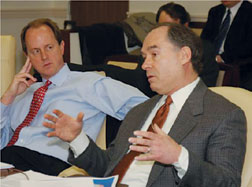 Commissioners’ views differ, but Schenendorf (right) sees middle ground.
|
When transportation officials get together these days, worrisome questions are in the air. How can a 2009 Highway Trust Fund shortfall be fixed? Should the gas tax be replaced as a prime financing source? Many are looking to a congressionally mandated report, expected soon, for some answers.
In the 2005 SAFETEA-LU law, Congress set up a National Surface Transportation Policy and Revenue Study Commission and directed it to produce “a comprehensive study” of the system’s condition, needs, revenue sources and long-term financing. The 12-member panel, chaired by Transportation Secretary Mary Peters, has been working for 18 months. “We’re in the home stretch,” says Jack Schenendorf, commission vice chairman. “I think we’ll have the report ready by the time we said, which is the end of the year.” There is speculation that the study won’t be available publicly until January.
|
"The future of transportation funding will be shaped by debate over what role the federal government will assume."
|
The statute also established a second panel, a National Surface Transportation Infrastructure Financing Commission. Its report isn’t due until 2009.
Tom Skancke, policy and revenue commissioner and head of a Las Vegas-based consulting firm, expects the report to have “substantial recommendations and a road map” for meeting immediate and longer-term needs. “The current system is broken and it needs to be fixed, both from a funding and project-delivery perspective,” he says.
There are two schools of thought on the commission. Some members favor a strong or expanded federal transportation role. Others, siding with Bush administration views, prefer a reduced federal role and heavier reliance on the private sector. Schenendorf, a former top GOPaide on the House transportation committee, advocates a major federal role. But he says, “I believe there is a middle ground. I think that figuring out how to do these things wisely, both for the current generation and future generations, is what we should be striving for.”
David Bauer, American Road and Transportation Builders Association senior vice president for government relations, says the study and recommendations from other groups will go to lawmakers working on the bill that succeeds SAFETEA-LU, which lapses on Sept. 30, 2009. For the new bill, “The crux of the debate will be the role for the federal government,” Bauer says.
“We’re anxious to see what’s in the report,” says Jay Hansen, National Asphalt Pavement Association vice president for government affairs. If the study is a consensus vision for the transportation program, “it could be a real winner,” Hansen says. But if it reflects division, he doubts it will go very far.

Post a comment to this article
Report Abusive Comment